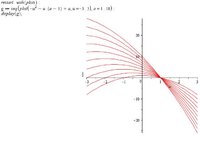
I've got two equations here that I need to work out the null clines for.
I've set both equations to 0.
For the du/dt equation, after setting the equation to 0 I attempted to solve for u but wasn't able to factorise any further than getting the line:
a+u-au-u^2 - v=0
I've tried to attempt the dv/dt equation.
Factorising v out to get
v(bu-c)=0
I got v=0 and bu-c=0
Does anyone know anything further about null clines and able to tell me where I'm supposed to go with this?
Thanks


